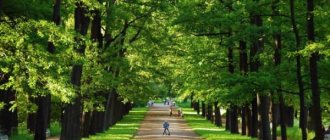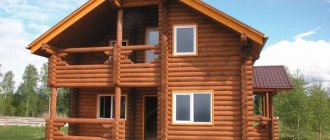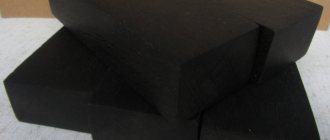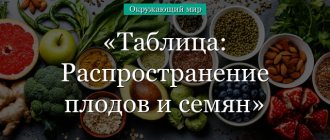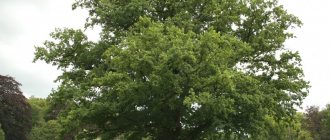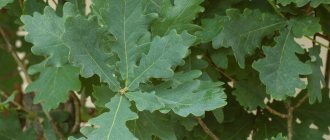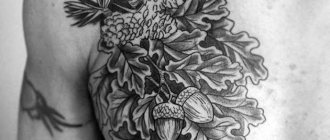G.
Type of sheet according to the ratio of length, width and location of the widest part:
D.
Leaf edge shape:
Write down the numbers in your answer, arranging them in the order corresponding to the letters:
| A | B | IN | G | D |
Oak leaf: petiolate, with pinnate venation, pinnately lobed, oval, lobed.
1) laurel type - evergreen, entire (or finely toothed only at the apex), with equally spaced parallel veins (almost the entire subgenus Cyclobalanopsis and a number of species of the subgenus Erythrobalanus);
2) type of holly - evergreen, hard, small, with a few veins, sometimes bifurcating at the end, and spiny teeth (subgenus heterobalanus - Helerobalanus);
3) chestnut type - summer green leaves with numerous parallel secondary veins equally spaced from each other, usually running into pointed (sometimes with long pointed) teeth (subgenus Quercus);
4) a type of lobed or lobed-toothed leaves with evenly or unevenly spaced lateral veins (subgenus Quercus);
5) a type of lobed-toothed leaves, the blades of which are long pointed at the ends, with unequally spaced lateral veins and numerous intercalary ones (subgenus erythrobalanus).
The genus includes about 600 species [3]. The natural habitat of oak is the temperate regions of the Northern Hemisphere. The southern limit of distribution is the tropical highlands; several species are also found south of the equator.
The oak tree is well recognizable thanks to its fruits, acorns, which are essentially nuts.
Description [edit | edit code ]
Most oak trees are healthy, dense trees. Many species of this genus belong to the so-called evergreens, that is, they are equipped with leathery leaves that remain on the plant for several years. In others, the leaves fall off annually or, when dry, remain on the tree and are gradually destroyed. Most evergreen species have entire leaves, others have lobed leaves. The flowers are monoecious: male and female on the same plant. Female flowers form small bunches or earrings, while male flowers are collected in hanging or standing, often long earrings. The floral integument is simple, poorly developed, but at the base of the female flowers many scale-like leaves are formed, located on an annular ridge, which is nothing more than an overgrown receptacle. Flower formula: ∗ P ( 6 − 8 ) A 6 − 10 G 0 <(6-8)>;A_<6-10>;G_<0>> and ∗ P 3 + 3 A 0 G ( 3 _ ) < 3+3>;A_<0>;G_<(<3>>)>> [4] .
When the fruits ripen, this roller, together with its scales, grows even more and thus a characteristic saucer is formed - a plus, which envelops the oak fruit, or acorn, from below. In different types of oak, the size of acorns and the shape of the scales are extremely varied: in some the scales are very small, in others, like the Hungarian oak, they are almost a centimeter long, turned away, etc. The ovary of oak flowers is almost always three-locular; but during the ripening of the fruit, only one nest grows and a single-seeded fruit with a strong, leathery pericarp is obtained, which is classified as a nut-shaped fruit.
Application
Energy properties. Oak is a tree that provides energy and helps treat cardiovascular diseases. Oak activates the immune system in case of chronic diseases, helps with polyarthritis, and improves brain activity.
Use in landscape design
D. petiolate is decorative with a thick, lush crown, leathery leaves that turn yellow in the fall. Decorative durability 70–80 years. Suitable for gardens, parks, squares, boulevards. Valuable for field protection and forest reclamation plantings. For soliter and alley plantings, a pyramidal form can be recommended (Q. robur f. fastigiata (Lam.) Schwarz). The multi-leaved form (Q. robur f. heterophylla (Loud.) C. Koch) with beautifully cut, drooping leaves is very decorative. However, this form grows slowly and achieves high decorative value only in a good agricultural background.
Medicinal use
Collection and processing of medicinal raw materials
Application in official and folk medicine
Therapeutic effect: diuretic, astringent, cardiotonic, hair strengthening.
Indications for medical use: diseases of the digestive system, diseases of the cardiovascular system, diseases of the respiratory system, diseases of the ear, throat, nose, diseases of the skin and subcutaneous fat, diseases of the oral cavity, infections and infestations.
The most famous types [edit | edit code ]
Different types of oak are common in temperate and warm countries; in hot countries - in the mountains. In South America, with the exception of its northern tip, there is none; They are also not available in Australia; in Africa only in countries near the Mediterranean Sea. In central Europe there are up to 20 species.
Read also: Is cumin dill or not?
In Russia, only one species is significantly widespread - English oak ( Quercus robur
L.) with two varieties: the difference between them is that one blooms in mid or late spring - this is the
summer oak
, and the other two or three weeks later - this is
the winter oak
.
Oak reaches in northwestern Russia as far as Finland, up to 60° and even 61° northern latitude. In the eastern direction, the northern limit of oak distribution gradually descends to the south, and, approaching the Ural ridge, drops to 57° and somewhat to the south. The Urals are the eastern border of the pedunculate oak range.
In western Russia and on the Black Sea coast of the Caucasus there is a species that is very common in the rest of Europe - Sessile Oak ( Quercus petraea
(Matt.) Liebl. ). Both of these oaks make up the main composition of Russian oak forests and groves, the number and extent of which are decreasing every year.
Another species grows in the Amur region and the Far East - Mongolian oak ( Quercus mongolica
Fisch. ex Ledeb. ), jagged oak is less common there. There is a small relict grove of Mongolian oak in Transbaikalia, not far from the Uryupino border post [5].
In the 1950s–1980s, attempts were made to acclimatize oak in the Altai Territory. If the plantings of the 1950s took place with varying degrees of success, then the plantings of the 1980s turned out to be successful: oaks took root and bear fruit, acorns are carried by birds and chipmunks over considerable distances, where they also take root [6].
Spreading
English oak is distributed throughout Western Europe and Russia (the European part). You can meet it in western Asia and northern Africa. It was spread throughout North America.
Since oak has a well-developed root system that goes deep into the ground, the tree is resistant to strong winds. It is used in protective afforestation.
It grows well with hornbeam, birch, pine, linden, and ash. Oak is a heat-loving plant that does not tolerate frost well. He doesn't like shading from above.
Usage [ edit | edit code ]
Oak timber and ornamental timber are produced mainly by the named Russian-European species. Of the other types of oak, the most important is Cork Oak ( Quercus suber
), growing in southern France, Spain, Algeria, and on the Black Sea coast of the Caucasus. It is remarkable for the unusually thick layer of cork that forms in its bark. This layer is several centimeters thick and is used to make bottle caps. Removal of this cork layer begins with 10- or 15-year-old trees. The first plug is no good, but after 8-12 years a new one grows, which goes into use. After the second shooting, the third layer is removed after a certain period of time, etc.
Evergreen Holm Oak ( Quercus ilex
), growing in Italy and in the Mediterranean region in general, produces sweet acorns that are used as food. Many oaks in the east and in warm countries of America, especially in California, are distinguished by the same thing; they were widely used as food by the American Indians. In addition, acorns are used to feed livestock. Acorns from oak trees growing in Russia are used only for making acorn coffee.
Also, under oak trees, forming a symbiotic relationship with their root system, grow the most expensive mushrooms - truffles.
In music[edit | edit code ]
The magic flute from W. A. Mozart's opera is carved from thousand-year-old oak wood. The magic flute then turns into gold.
Coffee drink made from acorns [edit | edit code ]
The powder for the coffee drink can be prepared in advance or used fresh. It should be borne in mind that pre-prepared powder quickly loses its aroma due to evaporation and destruction of the oils included in it. To prepare a freshly ground coffee drink, specially harvested and prepared acorns are ground in a coffee grinder and brewed like coffee. Ripe, large acorns of green color are harvested, hard to the touch, since soft ones that can be pressed with a finger are wormy. One of the drying options: spread the washed acorns on a baking sheet in one layer and place in a preheated oven. During this time, most of the acorns will burst from the evaporation of moisture inside and turn dark brown. After ten minutes, remove and shell the acorns. To prepare the coffee drink powder, while they are hot, grind the acorns through a meat grinder and place the resulting “minced meat” on baking sheets for further drying in the oven with the door open. Store in a dark place, in a hermetically sealed jar, or in a hygroscopic linen or paper bag.
Read also: Why does aloe turn yellow at home?
Oak bark [edit | edit code ]
Oak bark contains a lot of tannic acid, and therefore is used for tanning leather. Oak galls, or ink nuts, that is, pathological formations on the leaves (caused by the laying of eggs in the leaves by insects of the genus Cynips [en]
), also contain tannic acid and a dye used for tanning, making paints and writing inks.
Such nuts are formed on the oak growing in central Russia, and on the Asia Minor and Greek oak - Quercus infectoria
, etc. In the same countries,
Quercus aegilops
, the fruit saucers of which are also used for tanning and are the subject of significant trade.
In the downy oak ( Quercus pubescens
) from the Eastern Mediterranean and neighboring areas of Asia, they are used for tanning leather, dyeing fabrics and producing ink.
Masters of wood plastics use a decoction of oak bark to obtain the effect of ebony [7]:89.
Oak bark is used as a medicine [ citation omitted 393 days
] . Tannins have an astringent and anti-inflammatory effect, “fixing” the intestines during diarrhea. An infusion or decoction is good as a gargle for infections of the mouth and throat, as well as for inflammation of the gums. It “tans” the mucous membrane and thereby deprives bacteria of a nutrient medium. Later, the hardened mucosa is replaced by new, healthy tissue.
In ornamental gardening [edit | edit code ]
Oak trees are often planted for urban landscaping; So, swamp oak ( Quercus palustris
) is one of the most popular species in the eastern United States and Europe, and the evergreen Virginia Oak ( Quercus virginiana [en] ) is found in the southern United States.
In the 18th-19th centuries, oak was often used as a tapeworm
in palace and manor parks. In this case, it was usually planted in a clearing in front of the manor's house.
Quercus suber) can be successfully grown
).
What type of leaf arrangement does maple have?
| Plant name | Leaf blade shape | Type of leaf arrangement |
| Maple | palmately dissected | next |
| Birch | cordate | next |
| Plantain | lanceolate | whorled |
| Lilac | cordate | opposite |
Interesting materials:
How to see who a person likes in the VK application? How to see people nearby in VK? How to see a person's new subscriptions on Instagram? How to see another person's subscribers on VK? How to view all a person’s posts on VK? How to give an injection in the buttock of an adult? How to put a page of a deceased person on VK? How to congratulate a person on Easter? How to call a person if there is no Beeline money? How to call a person if you don't have money on your phone?
Wood [ edit | edit code ]
Oak wood is distinguished by its strength, strength, density, hardness and heaviness. The properties of wood depend on the growing conditions of the tree. This is how it differs:
- bog oak
,
oak
or
stone
, grown in dry sandy places - in oak groves or pine forests; its bark is thick, almost black; the wood is fine-grained, straw-yellow in color, hard, but has little elasticity; - ols oak
,
lead
,
iron
or
water oak
, growing along the banks of flowing waters and in elevated places, among alder swamps (
ols
); it has leathery bark of a light bluish-gray color, covered with whitish spots, and a straight trunk with a dense, rarely dry, top; large-layer wood with a pale pink tint and white sapwood, very heavy, very elastic, but very cracking when dried; - in the middle places between the pine forest and the olsa, an oak tree grows with wood of transitional qualities - yellowish, with white sapwood, more elastic than the oak oak, but lower than the olsa oak, and inferior in hardness to both; the bark on the trunk is thick, soft, gray-brown, covered in cracks with a reddish coating, and on the north side with greenish moss; dryness and hollowness of the butt part of the trunk are quite common.
Oak wood is an excellent building and ornamental material: it is used for underwater and land buildings, the construction of underwater and main parts of wooden ships (mainly summer oak) and as cooperage, carriage, machine, furniture, parquet and carpentry timber (winter oak is preferred); The latter especially value bog oak, which has lain in water for a long time (up to a hundred years) and has dark, almost black wood. Suitable for artificial aging (brushing).
Read also: Black radish chemical composition
Even cannonballs fired from cannonballs could bounce off the sides of the USS Constitution, made of Virginia oak [8].
Although the heat of combustion of oak wood is higher than that of other wood species in central Russia, complete combustion of oak wood requires a large air draft; oak charcoal does not hold heat well.
Leaf venation
Veins connect the leaf to the stem. These are vascular-fibrous bundles. Their functions : conductive and mechanical (the veins serve as support and protect the leaves from tearing). The arrangement and branching of the veins of the leaf blade is called venation . Venation is distinguished from one main vein, from which lateral branches diverge - reticulate, pinnate (bird cherry, etc.), fingered (Tatar maple, etc.), or with several main veins that run almost parallel to one another -– arc (plantain, lily of the valley) and parallel (wheat, rye) venation. In addition, there are many transitional types of venation.
Most dicotyledons are characterized by pinnate, palmate, reticulate venation, while monocotyledons are characterized by parallel and arcuate venation.
Leaves with straight veins are mostly entire.
Oak in oral folk art [edit | edit code ]
In the cosmic worldview of the Slavs, the world tree was transformed into the folklore image of an oak tree growing on the island of Buyan, in the middle of the Ocean-Sea. “On the Sea-Ocean, on Buyan Island there is a green oak tree,” - this is how many Russian folk tales begin [12]. According to the beliefs of the ancient Slavs, the snake Zmiulan, who embodies the element of fire, lives in the hollow of an ancient oak tree. He can inspire love in a woman in order to marry her. As a wedding gift, the snake brings jewelry, which it takes out through a hollow from underground storerooms. Men who wanted to inspire love for their chosen one turned to Zmiulan for help. In Rus' there was a belief that Nikola Duplinsky lived in the hollow of a huge oak tree. And if you pray to him earnestly, he will fulfill any desire [7]: 40-41.
Some peoples believed that hollow trees felled by a storm could restore youth to a person and bring health. Such a tree in G. Longfellow’s poem “The Song of Hiawatha” turns out to be an oak:
On their way, in the wilds of the forest, an Oak lay, perished in a storm, a giant Oak, covered with moss, half-rotted under the foliage, blackened and hollow. Seeing him, Osezo suddenly let out a sad cry and jumped into the hollow, like into a hole. Old, dirty, ugly, He fell into it, and came out - Strong, slender and tall, a handsome young man! [7] :41
King Holly and King Oak are an archetype identified by Robert Graves in European folklore, eternal opponents, each of whom belongs to half the year.
Internal structure of the leaf
The outside of the leaf is covered predominantly with a single-layer, sometimes multi-layered epidermis (skin). It consists of living cells, most of which lack chlorophyll. Through them, the sun's rays easily reach the lower layers of leaf cells. In most plants, the skin secretes and creates on the outside a thin film of fatty substances - a cuticle, which almost does not allow water to pass through. On the surface of some skin cells there may be hairs and spines that protect the leaf from damage, overheating, and excessive evaporation of water. In plants that grow on land, there are stomata in the epidermis on the underside of the leaf (in wet places (cabbage) there are stomata on both sides of the leaf; in aquatic plants (water lily), whose leaves float on the surface, there are stomata on the upper side; in plants that are completely immersed in water do not have stomata). Functions of stomata : regulation of gas exchange and transpiration (evaporation of water by leaves). On average, there are 100–300 stomata per 1 square millimeter of surface. The higher the leaf is located on the stem, the more stomata per unit surface.
Read also DIY aviary for squirrels
Between the upper and outer layers of the epidermis there are cells of the main tissue - assimilation parenchyma. In most species of angiosperms, two types of cells of this tissue are distinguished: columnar (palisade) and spongy (loose) chlorophyll-bearing parenchyma. Together they make up mesophyll . Under the upper skin (sometimes above the lower one) there is a columnar parenchyma, which consists of cells of regular shape (prismatic), arranged vertically in several layers and tightly adjacent to one another. Loose parenchyma is located under the columnar and above the lower skin, consists of irregularly shaped cells that do not fit tightly to one another and have large intercellular spaces filled with air. Intercellular spaces occupy up to 25% of the leaf volume. They connect to the stomata and provide gas exchange and transpiration of the leaf. It is believed that photosynthesis processes occur more intensively in the palisade parenchyma, since its cells have more chloroplasts. In the cells of loose parenchyma there are significantly fewer chloroplasts. They actively store starch and some other nutrients.
Vascular-fibrous bundles (veins) pass through the parenchyma tissue. They consist of conductive tissue - vessels (in the smallest veins - tracheids) and sieve tubes - and mechanical tissue. The xylem is located on top of the vascular-fibrous bundle, and the phloem is located below. Organic substances formed during photosynthesis flow through sieve tubes to all plant organs. Through vessels and tracheids, water with minerals dissolved in it flows to the leaf. Mechanical tissue provides strength to the leaf blade, supporting the conductive tissue. Between the conducting system and the mesophyll there is a free space or apoplast .
Monument oaks and protected oaks [edit | edit code ]
There are many individual trees in the oak genus that have become widely known either because of their age, size, or other unique reasons. Many of them are considered tourist attractions and are protected. Among them we can note: Mamvrian oak, Stelmuzhsky oak, Pansky oak, Tsar Oak, Kaiser Oak, Chapel Oak, Bogatyr of Taurida, 600-year-old oak.
The oak grove in the vicinity of the village of Shemakha is a protected area in the Chelyabinsk region, the extreme north-eastern distribution area of pedunculate oak.
Nuts
The fruits of the pedunculate oak are bare, placed on a long stalk. Its size is three to eight centimeters. The color of acorns is brownish-brown. Their length is one and a half to three and a half centimeters, diameter is one to two centimeters. The nut is placed in a saucer called a plyuska. The fruits ripen in September-October.
Acorns are characterized by good germination. They are spread by birds, especially jays. Up to ten years, seedlings grow slowly. Then the growth accelerates to thirty-five centimeters per year, sometimes more.
Leaf modifications
Leaf modifications (metamorphoses) occur when additional functions are performed.
Mustache
Allow the plant (peas, vetch) to cling to objects and secure the stem in a vertical position.
spines
Occurs in plants that grow in dry places (cactus, barberry). Robinia pseudoacacia (white acacia) has spines that are modifications of stipules.
Scales
Dry scales (buds, bulbs, rhizomes) perform a protective function - protect against damage. Fleshy scales (bulbs) store nutrients.
In insectivorous plants (sundews), the leaves are modified to trap and digest mainly insects.
Phyllodes
This is the transformation of the petiole into a leaf-shaped flat formation.
Leaf variability is caused by a combination of external and internal factors. The presence of leaves of different shapes and sizes in the same plant is called heterophyly , or diversity of leaves . Observed, for example, in water yellow, arrowhead, etc.


